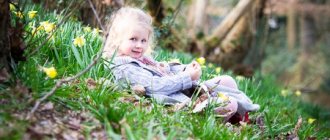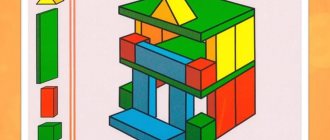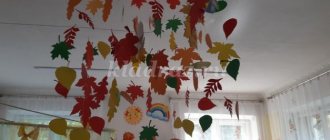Card index of construction games for children of the younger group
Natalia Vasilievna Volokitkina
Card index of construction games for children of the younger group
" Building a house for a cat , a dog and a goat"
Goal: Develop children's to build a house . Learn to build in the required sequence. Promote cooperative play
Material: cubes and bricks, plates.
Progress of the game: - Look, it’s raining, and our puppy Bimka is wet, he’s sitting under a tree and shaking. He needs to build a warm house - a booth. The teacher suggests building a house for the dog . Children select the materials themselves and invent the house themselves.
"Animal pen"
Goal: Learn to build from vertically placed bricks. Foster careful handling of construction . Activate vocabulary: brick, pen
Material: bricks.
Progress of the game: The teacher brings a set of plastic pets and offers to build a pen for them so that they do not run away and are not eaten by wolves. It must be built from bricks placed vertically.
" Building a truck , roads"
Goal: To consolidate the ability to tightly lay bricks flat to each other with the narrow short side (road)
.
Place the cube firmly and evenly on the second brick (machine)
.
Material: cubes and bricks.
Progress of the game: The teacher brings a traffic light to the group , the children remember what they know about the traffic light. Let's build a road and a car , shows how to build , plays with buildings .
"Gate for Aibolit car"
Goal: Learn to build a gate from two vertically standing bricks, on which another brick is placed. Material: bricks
Progress of the game: Attention, the tiger in the zoo is sick. The good doctor Aibolit is driving a car to cure a sick person. The car enters the park, trees prevent us from driving further. You and I urgently need to build a gate for the car . Children offer their buildings .
"The doll has a housewarming party"
Goal: To consolidate the skills and abilities of working with building materials , teach how to play with buildings , and enrich the experience of children . Construction of furniture , rooms in various ways.
Material: cubes and bricks. prisms, plates. cylinders.
Progress of the game: The teacher invites the children to become builders and build entire rooms with furniture for the dolls. Choose your own building material . Friends for work, and placing the dolls in a new home.
"Town for Dolls"
Goal: Continue to create buildings according to the general plot .
Material: prism cubes and bricks, plates. cylinders.
Progress of the game: - Look, our dolls were very upset , they had a fire, all the houses in the city burned down. Therefore, they need to be helped and built new houses . Let us help our toys, create our own houses, come up with our own buildings .
"Folding the figures"
Goal: Acquaintance with the concepts of shape, color, size, creation of initial mathematical concepts: acquaintance with geometric figures, their main features, learning to count.
Material: a set of planar geometric shapes in primary colors, frames, cut shapes.
How to play: Take out the inserts, for example circles, and invite the child to collect them on the table, and then put them in the corresponding windows. Then assemble triangles and squares in the same way.
“We come up with figures”
Goal: To develop logical thinking, attention, memory, speech, development of fine motor skills, preparing the hand for writing, development of imagination, creative activity.
Material: a set of planar geometric shapes in primary colors, frames, cut shapes.
Progress of the game: The child can come up with and put together figures from various elements, give them names.
“A narrow bench for Bunny - Long Ear, a wide bench for Mishutka”
Goal: Learn to build a narrow bench from two bricks and a plate and a wide bench from four bricks and two plates.
Material: bricks and plates.
Progress of the game: Funny toys come to visit the children and tell the children that there are not even benches in the forest. The teacher invites the children to build a narrow bench for the bunny, and a wide bench for the bear. Children themselves select materials for construction .
"Collect circles"
Goal: To strengthen children’s to navigate homogeneous objects (larger, smaller, even smaller, small, selecting them in a certain sequence; teach them to enrich sensory experience when acting with a certain shape and different sizes, learning their physical properties.
Material: flat circles of different sizes and colors.
Progress of the game: Let's create a fairy-tale room and arrange the circles according to size, color, and your mood .
"Bridge for pedestrians"
Goal: Continue to learn two ladders and make an overlap (put a plate on top, play with the construction . Vocabulary: ladder, height, on top, bridge, next to, plate.
Material: cubes and bricks, plate
Progress of the game: Here we have a wide river. And you and I need to translate the toys. - What should we do? Of course, build a bridge . (The teacher builds a sample )
Invites children to build their own bridge and transport toys.
"Different Cars"
Goal: To strengthen children's understanding of the color and name of building parts .
Material: cubes and bricks, plates.
Progress of the game: You and I have already built a road and a car . and now you can come up with your own cars and build a whole garage of various cars. Children compare buildings . Name their cars.
Joint design activities in the 2nd junior group.
Summary of joint design activities in the 2nd junior group on the topic: “Gates for trucks.” Integration of educational areas: physical, cognitive, artistic-aesthetic, social-communicative, speech development.
Goal: To develop in children the ability to build gates: place supports (exactly one against the other) and carefully place a crossbar (brick) on them, decorate them (prism). To develop in children the ability to analyze a sample building.
Tasks:
- Cultivate a desire to build buildings.
- Arouse children's interest in activities with wooden building materials.
- Develop the ability to listen carefully to the teacher and answer questions posed.
- Improve constructive skills.
Preliminary work:
- Guessing riddles.
- Development of skills to understand schematic images of buildings.
- Learning finger gymnastics, physical. Minutes, round dance “Christmas tree - Christmas tree”
Materials: 1 large car with a multi-colored ball, for children small cars with 1 ball each in its own color, gate diagrams for each child (large and small), 2 cubes, one long brick, one prism (for children), 4 cubes, brick, prism (to the teacher), an envelope with a letter from a snowman, a Christmas tree.
Contents of organizational activities: Children enter the group room, stand near the tree with a covered sheet.
The teacher makes a riddle about the Christmas tree:
- What kind of girl is this? Not a seamstress, not a craftswoman. She doesn’t sew anything herself, but wears needles all year round ?
We also have a Christmas tree, but is something missing? (toys) What to do? (there is a letter by the tree) Look here there is a letter from the Snowman, now I will read it. Hello guys! Trucks with toys are stuck behind the fence and need help to bring toys for the Christmas tree. Here's a diagram for you. Children go to the tables and look at the diagrams.
What is this on the diagrams (gate).
What construction parts do you see? (cubes, brick, prism)
What color are they? What kind of gate is needed for a large car? And for the little one? How can we help trucks? (build a gate)
Before construction, let's stretch our hands.
Finger gymnastics: “Truck and gate”
There's a truck in the clearing. Imitation of a steering wheel in the hands. Well, the way is blocked for him. Palms are folded edge-to-edge towards each other. We open the gate. Palms are turned towards each other. We invite our truck. Waving our hands towards ourselves.
They go to the fence with a large car.
– Look how I will build a gate (show)
I will build the supports from cubes, placing them opposite each other like this. I'll add one more cube to them. I will build the crossbar out of brick. I place it on the supports with the wide side. And on top of the crossbar I will place a prism on the long narrow side.
– Have we got a gate?
– What kind of cars do you think can get through such a gate, small or large cars? (large)
Rolling a large car through the gate to the tree.
– What is in the car? (ball). What colour is he? (answers). How many balls? (one). Hang the ball on the tree
– We still have cars, what size are they? (small). What kind of gate will you build? (small). But let’s do a warm-up first.
Phys. just a minute:
- Come with us (Raise your arms to the sides)
- Let's stomp our feet, (Stomp our feet while standing still)
- Let's clap our hands, (Clap our hands)
- Today is a good day! (Raise straight arms up to the sides)
Now you build the gate yourself. Construction of gates by children
- Well done, what a wonderful gate you have made. Take the car and drive it through your gate to the Christmas tree.
Individual questions for children: What type of car? (small). What's in it? (ball). What colour is he?
All toys are hung on the Christmas tree. How many Christmas trees do we have? (one). How many toys does she have? (a lot of). Guys, tell me, what did you build today? (Gates). Did you enjoy building? Now let’s go near the Christmas tree and start a round dance. Round dance “Christmas tree - Christmas tree”.
MAGAZINE Preschooler.RF
Summary of direct educational activities on construction in the 2nd junior group “Gate Construction”Municipal budgetary preschool educational institution Child Development Center kindergarten "Korablik"
Prepared by: teacher of the first qualification category Vostryakova E.N. Udomlya
Target:
Develop in children the ability to build a simple floor: place supports (exactly one opposite the other) and carefully place crossbars on them. To develop in children the ability to analyze a sample building.
Tasks:
- Cultivate a desire to build buildings.
- Arouse children's interest in activities with wooden building materials.
- Develop the ability to listen carefully to the teacher and answer questions posed.
- Improve constructive skills.
Materials:
Illustration of kindergarten gates, cars of different sizes, gate diagrams
Dispenser: three small bricks, one long brick, two high bars. The demo is the same.
STROKE:
Stage 1: motivational.
- The goal of the teacher at this stage of the educational activity is to motivate children to play activities; develop emotional responsiveness and cognitive activity.
The goal that children should set for themselves is to build gates for cars.
An animation of the song “Beep-Bee-Bee” and cars come to visit the children. Develop emotional responsiveness.
Children enter the group room, greet guests and sit on chairs next to the teacher.
— Guys, look, a lot of cars came to our group today. They are not empty, but loaded with construction parts.
- Encourage children to think independently, encourage children with positive comments: “Clever” for girls, “Well done” for boys.
Stage 2 based on the personal experience of children (survey of children):
Pedagogical goal: To activate children’s personal experience, their ability to recognize and name construction parts.
The goal that children must achieve: Remember and name construction parts.
Educator:
- Let's see what construction parts are in our cars.
- What is this? (brick)
-What can you build from bricks? (house, path)
— And when you went to kindergarten in the morning, you saw the gate. They are beautiful and wide. (showing the gate)
- What do you think the gates are for? (come in, go out)
— Do you want to learn how to build gates? (Yes)
Stage 3 is the main one.
Pedagogical goal: To develop in children the ability to build a simple floor: place supports (exactly one opposite the other) and carefully place crossbars on them. To develop in children the ability to analyze a sample building.
The goal that the children set: Build a gate.
The teacher gives simple explanations. All the details are different, they differ from each other either in shape, or in color or in size.
- Introduction and examination (examination and identification of sensory signs of building parts)
— Look how I will build a gate (show)
I will build the supports from bricks, placing them opposite each other like this. I will also build the crossbar from small bricks. I place it on the supports with the wide side.
- Demonstration of the phased construction of gates.
— Do we have a gate?
— What kind of cars do you think can get through such a gate, small or large cars?
- Guys. Small cars can pass through these gates.
- Look. How I drew this gate. (shown on the diagram)
“Now you can build the gate yourself.”
- Let's imagine. That we got into our cars and went to a construction site to build gates. But before our cars go, we need to pump up the tires (Imitation) and start the engines (Imitation).
- At this stage, NOD relieves muscle tension.
Note: Children work at tables.
- Well done, what a beautiful gate you have made. Now take the car and drive it through your gate. Happened? (Children's answers).
- At this stage, children's activities are independent in creating and playing with buildings.
Stage 4: consolidating the experience gained on new material.
Pedagogical goal: To consolidate the experience gained by children using new material.
Goal for children to set: Build a big gate.
— Guys, I also brought you big cars. Tell me, can this car drive through your gate? (Children try).
- Create a problem situation, Encourage children to think independently.
The teacher opens the screen, showing the large gate.
-Look how I built it. This gate has a support, a crossbar, and we will build it from other building parts. The supports are made of bars, the crossbar is made of long bricks.
— I suggest you build the same gates for large cars. Come, take big cars and build big gates for them.
- At this stage, children's activities are independent activities.
— Did your cars pass through the gate? Did you get the same gate as mine?
- At this stage, GCD compares your construction with the model.
Stage 5 – final:
Pedagogical goal: Aim at generalizing the experience gained and applying it in the game.
The goal that the children set is to play with cars now, and tomorrow to build gates for other cars.
— Guys, tell me, what did you build today? (Children's answers). Did you enjoy building? (Yes).
- Well done, what a beautiful and durable gate you have made. We will still play with you tomorrow, we will definitely build more gates for other cars. Now let's invite the cars to stay in our group and you can play with them. (Children agree).
Animation starts and children play with the buildings.
| Next > |


